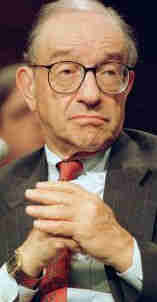So, the economy is moderating, inflation is still historically low, and stock prices have become more judiciously priced. This must mean that the Fed is getting ready to cut interest rates, right? Wrong. One of the reasons why some believe that the Fed could be inclined to bring a rate cut to the table is that the economy is slowing and could continue to slow further -- allowing a recession to unfold without any rate action seems, on the surface, unlikely. Nevertheless, a stimulatory action on the part of the Fed requires, in large part, that inflation not be an immediate concern. However, despite the reported decrease in economic activity, inflation has not been falling. In fact, as the economy has cooled it has actually been rising, and not solely because of energy prices either. Annualized core CPI is currently running at 2.8% after coming in at 1.9% for 1999. Add to this the largest spike in clothing costs in a decade, stunning gains in tobacco, and the regular up-tick in health costs reported in September CPI, and you have areas of concern: Inflationary areas. While the increased rate of inflation has justified, in hindsight, the previous six rate hikes Greenspan has inflicted upon the economy, it has also brought about a fearful comparison to the 1970s, a time when stagflation characterized the economy, and equity growth suffered. Where inflation is the concern, interest rates are not likely to be cut since that would further exacerbate the inflationary environment. Where interest rates are high, capital is likely to flow into those areas with a high guaranteed returns. In such an environment, equity prices themselves are likely to stagnate and then decline. The Previous Crisis Cuts The last time the Fed cut interest rates was back in 1998 in direct response to the potential pressures arising from the Asian crisis. Not only was Greenspan weary of high stock prices back then (which may have limited his eagerness to cut interest rates in the first place), but inflation was largely contained. "We're in this ridiculous situation where the Fed is waiting for the stock market to go down before they can ease". John Makin, American Enterprise Institute, August 25, 1998. As it turned out the Dow bottomed at 7379.70 on September 1, 1998, and the first 1/4 point cut arrived on September 29. The next two cuts followed in October and November. The highly valued equity markets rose prior to the cuts and in the case of the Nasdaq did not stop rising until March 2000. The Fed must have marveled at the resilience of investors. Nevertheless, recall that at the time the Fed was setting rates in response to an external crisis rather than attempting to manage a domestic inflationary increase. It took the Fed until November 1999 before they could orchestrate the Federal Funds rate back to 5 1/2%, the pre-Asian Flu mark. The Coming Crisis Cut? So what lessons does the last series of rate cuts hold for today? Well, for one, don't hold your breath for a rate cut even in the event of a domestic equity correction or possible economic recession. The notion that the Fed is waiting solely for lower stock prices before they cut rates does not define the whole gamut of their concerns: considering that inflation is rising and the labor market remains tight, on what basis could the Fed justify a cut in the near future? Sorry market maniacs, you can not have it both ways: if the Fed should not and did not raise interest rates to try and control the markets back in 1999, then why should they cut rates to let them loose? The problem with expecting the Fed to cut rates solely because the stock market continues lower or because a major default has been announced is that it expects exactly what Greenspan has previously recommended banks not to do: that being lending money with open arms without regard to sound credit quality analysis. The degenerating credit quality of corporate American speaks for itself, and Greenspan's position on the issue is clear: "...we have chosen capital standards that by any stretch of the imagination cannot protect against all potential adverse loss outcomes... Hundred-year floods come only once every hundred years. Financial institutions should expect to look to the central bank only in extremely rare situations." Greenspan - Mini Crash Day - April 14, 2000 We all know that the Fed won't let the financial system unravel without a fight, but hoping that your portfolio will benefit from an interest rate cut in the not too distant future may be myopic. The crisis this time, if US stock volatility is any indication, may be born in the US. Unlike 1998, capital may be flowing out of rather than into the US "safe" haven. If this is the case, then the consequent decrease in the value of the dollar may prevent the Fed from lowering interest rates in response. When coupled with the inflationary straightjacket that the Fed may be facing, the picture for the equity markets does not appear all that rosy. Doesn't exactly make you want to hop back into the markets hoping for another crisis cut, does it? The objectives at the Federal Reserve Board must be to remain cautious against inflation, slower GDP growth or not. In 1998 investors responded to the cuts with exuberance -- this exuberance will not be unleashed so readily until inflation is be seen to be firmly under control. If a period of stagflation and then a subsequent recession is the only alternative to receive this end, so be it. 'Easy Al' was a good nick-name while it lasted. It may now be time to say hello to the 'Hammer' Greenspan.
|

